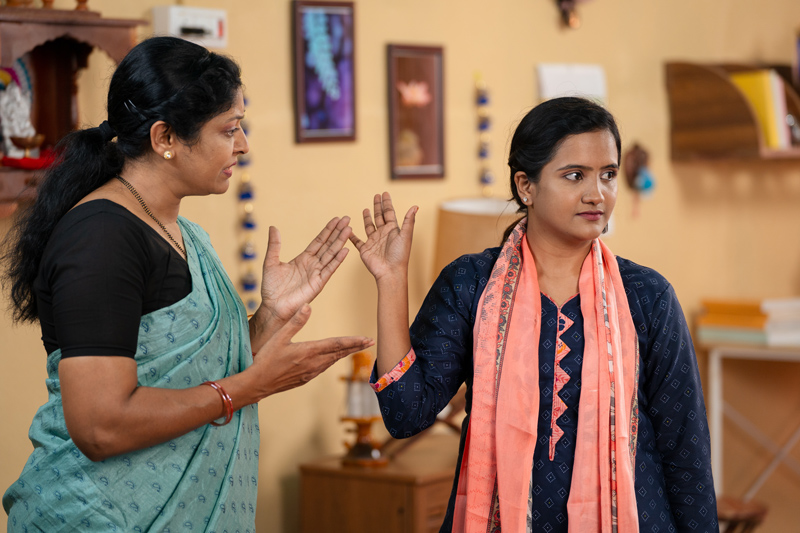In South Asian societies—including India, Pakistan, Bangladesh, Sri Lanka, and Nepal—the mother-in-law and daughter-in-law relationship is often portrayed as a cornerstone of family life. While cultural narratives admire harmony and respect within the family system, the reality is often more troubled. For many women, marriage means being absorbed into a rigid familial hierarchy where the mother-in-law wields significant control. This dynamic, preserved through generations, can take a silent but severe toll on mental health.

Upon marriage, South Asian women are typically expected to leave their natal homes and adapt to the rules of their husband’s household. In this setting, the mother-in-law often acts as the gatekeeper of tradition, family honor, and daily decision-making. The daughter-in-law is positioned at the bottom of the hierarchy, expected to fulfill duties without question, defer to elders, and navigate family politics without appearing defiant. Such environments often lack emotional support and autonomy, two elements required for psychological well-being.
A study from Oklahoma State University found that 35% of South Asian American women reported psychological abuse, and 23% reported emotional abuse by their mothers-in-law. These forms of abuse ranged from verbal criticism to manipulative control over finances, child-rearing decisions, and even healthcare access. In another study conducted in rural Pakistan, the mother-in-law was identified as a significant contributor to perinatal stress, with women reporting increased levels of anxiety and depression when their mothers-in-law dominated decisions around pregnancy and childbirth.
This phenomenon isn’t confined to immigrant or rural populations. In Bangladesh, a 2020 survey by BRAC University reported that 40% of newly married women felt isolated or mistreated within their marital households, with mothers-in-law cited as a leading source of emotional strain. Similarly, qualitative interviews from India conducted by the International Center for Research on Women (ICRW) revealed that many women experience the mother-in-law as a key enforcer of patriarchal norms, often pressuring daughters-in-law to bear male children or accept domestic abuse in silence.
In Nepal, researchers found that women with strained mother-in-law relationships had significantly higher rates of depression. Those who described their in-laws as “demanding” or “emotionally distant” reported more intense psychological symptoms and were less likely to seek external help due to familial pressure and social stigma.
The mental health consequences are profound. Constant criticism and control can lead to:
- Depression: Feelings of worthlessness, sadness, and exhaustion are frequently reported among women experiencing toxic in-law dynamics.
- Anxiety disorders: Anticipating unpredictable emotional outbursts or criticism creates chronic hypervigilance.
- Post-traumatic stress symptoms: Particularly when verbal or emotional abuse persists for years, women may develop symptoms like intrusive thoughts, emotional numbness, or sleep disturbances.
- Somatic disorders: Studies across South Asia note high rates of psychosomatic complaints such as headaches, backaches, and gastrointestinal problems among women in strained domestic relationships.
Beyond control and criticism, another dynamic complicates this relationship: envy. When a mother-in-law lives with her son and daughter-in-law, she may perceive the younger woman as a rival rather than a family member. Jealousy may stem from the daughter-in-law’s youth, beauty, or perceived privileges that the mother-in-law was never granted. These are things such as higher education, financial independence, or freedom to voice opinions. For mothers-in-law who grew up silenced by tradition, witnessing a younger woman speak up or make decisions with confidence can feel threatening. Many mothers-in-law may feel they sacrificed their own youth, beauty, or potential in service of family obligations. Rather than celebrating these advancements, some respond with hostility. The daughter-in-law becomes a living reminder of personal sacrifices never acknowledged.
This resentment often manifests in various ways. Passive-aggressive comments, constant fault-finding, and comparisons to other family members are common. In some households, this escalates to sabotage—undermining her authority in front of children, questioning her decisions, or turning other relatives against her. Over time, these actions create a toxic home environment marked by psychological distress. Many mothers-in-law are careful not to show hostility or manipulation in front of their sons. Their behavior often changes the moment he leaves for work, steps out of the room, or becomes otherwise occupied. In front of him, the atmosphere may appear cordial or even warm. This creates the illusion of a peaceful household. But once he’s gone, the daughter-in-law may face passive-aggressive remarks, criticism, or subtle undermining. This two-faced behavior makes it difficult for the daughter-in-law to explain what she’s experiencing. When she eventually does bring it up to her husband, she may be met with disbelief. The mother-in-law often denies any wrongdoing, becoming defensive or painting herself as misunderstood. The gaslighting that follows can deepen the daughter-in-law’s distress, leaving her to question her own perceptions and feel isolated in the home she’s expected to call her own.
And yet, despite strained or even openly hostile relationships, the daughter-in-law is often still expected to serve. She is to toil in the kitchen, remain obedient, smile through the stress, and even care for the very people who mistreat her. If her mother-in-law or father-in-law falls ill, she is often the one expected to nurse them back to health. There is an irony here: the woman viewed as an outsider or even an enemy is often the one performing the most intimate acts of care for the son whom the mother-in-law cherishes most.
What makes this dynamic even more complicated is the hypocrisy that often goes unspoken: many mothers-in-law have daughters of their own, yet the expectations for them are drastically different. Daughters are often treated with warmth, empathy, and protection—granted emotional space, gifted items, and supported when they are mistreated by others. But those same mothers-in-law may offer none of that compassion to their daughters-in-law. Instead of empathy, the daughter-in-law receives scrutiny; instead of gifts, she may receive duties. The contrast is jarring. When the roles are reversed, the rules change. A mother who would be devastated to see her daughter controlled or criticized by in-laws may have no hesitation in doing the same to another woman’s daughter. This selective empathy reinforces the cycle of harm and reflects the hierarchies that pit women against each other, even as they share similar struggles.
There is a lot of cultural silencing that surrounds this relationship. Speaking out is often equated with dishonoring the family or being ungrateful. Many women internalize their distress, believing their suffering is a rite of passage. Mental health services are scarce in many South Asian countries, and when available, they often lack the cultural nuance needed to address such deeply ingrained familial structures. Even among South Asian diaspora communities, the fear of judgment from extended family acts as a barrier to therapy or counseling.
However, some change is emerging. In urban centers across India, counseling services and family therapy programs are beginning to address conflict within families. In Pakistan and Bangladesh, grassroots initiatives are offering psychosocial support to women experiencing domestic stress. Online communities and helplines now offer more anonymous ways for women to seek support and validation. South Asian mental health professionals in the diaspora are also leading efforts to create culturally sensitive resources and spaces for dialogue.
Empowerment and education remain key. Programs that foster assertive communication skills and emotional literacy among both generations of women can help shift power dynamics. Encouraging husbands to play a mediating role—rather than passively observing—can also help protect their partners’ well-being. In some Indian cities, NGOs are running workshops that include mother-in-law and daughter-in-law pairs, helping them develop empathy through storytelling and role-reversal exercises.
Importantly, when a woman today stands up to her mother-in-law, she is doing far more than defending herself in a single moment. She is confronting generations of inherited silence, misogyny, and systemic injustice. She is not simply reacting to a rude comment or a controlling demand—she is reclaiming space in a world that has long denied her autonomy. Every boundary she asserts becomes an act of resistance, a small but vital shift toward selfhood in a culture that has historically asked women to disappear inside marriage.
It is crucial to reframe the expectations placed on daughters-in-law. Rather than viewing them as outsiders to be molded, families must begin to see them as equals. This shift requires effort from mothers-in-law who may be reenacting the same suffering they once endured. A study in Delhi revealed that many older women who were once mistreated by their own mothers-in-law felt justified in repeating the cycle, believing it to be a rite of authority.
Breaking this cycle demands a commitment to redefining what love and respect in a family truly mean. Respect should not be conflated with submission; love should not be conditional on obedience. For daughters-in-law suffering in silence, it is time we name the problem, validate their pain, and build a more supportive and equitable model of family life.
Vishwani’s opinions are her own and are for informational purposes only. They are not intended to diagnose, treat, or provide medical advice. Please consult a qualified healthcare professional for personalized medical care.
Vishwani Sahai-Siddiqui is a residency- and fellowship-trained psychiatrist, now a medical writer and editor, and the owner of The Cognitive Quill. For more information, please visit cognitivequill.com or email vishwanipsychmd@gmail.com.
South Asians and Mental Illness Series
- Therapy is for “Other People”: Why Many South Asian Parents Dismiss Mental Health Support
- The Burden of Being the ‘Good Child’: How South Asian Kids Suppress Mental Health Struggles
- Mental Health and Matchmaking: How Stigma Affects South Asian Marriage Prospects
- Spirituality Versus Psychiatry: Why Many South Asians Turn to Religion Before Therapy or Psychiatric Medication
- The Cost of Silence: How Ignoring Mental Illness in South Asian Families Leads to Physical Health Issues
- “The Son Belongs to His Mother”: South Asian Daughters-in-Law and the Mental Health Toll of Family Hierarchy
- Trapped by Tradition: The Anxiety of Being a ‘Good’ South Asian Daughter-in-Law
References
BRAC University (2020). Gendered experiences of newly married women in Bangladesh.
Chung, E. O., et al. (2022). Mother-in-law childcare and perinatal depression in rural Pakistan. Women’s Health, 18.
Delhi Women’s Collective (2021). Generational trauma and family power dynamics in urban India.
Gautam, R., et al. (2018). Intergenerational relationships and maternal mental health in rural Nepal. BMC Psychiatry.
International Center for Research on Women (ICRW). (2019). Gender norms and domestic expectations in India.
Wasim, F. (2014). South Asian American daughter-in-law/mother-in-law relationships, cultural values conflict, and help-seeking for domestic violence. Oklahoma State University.




